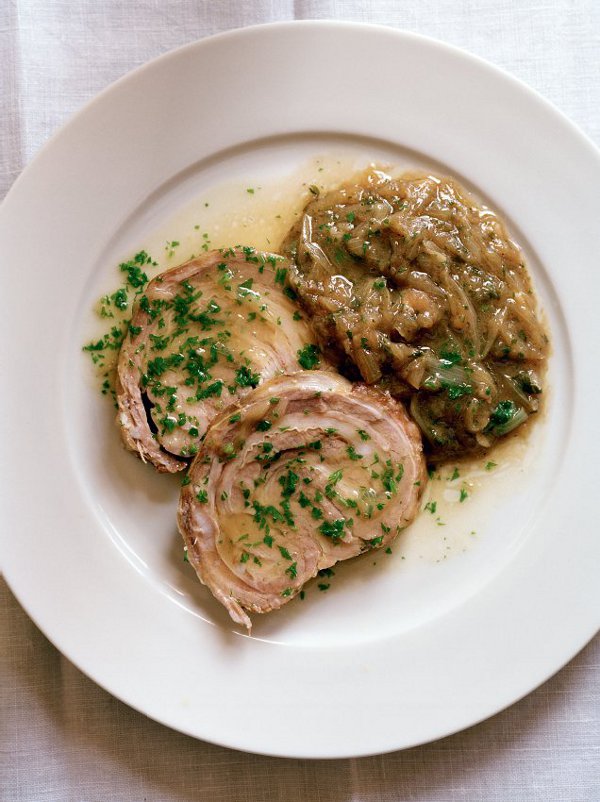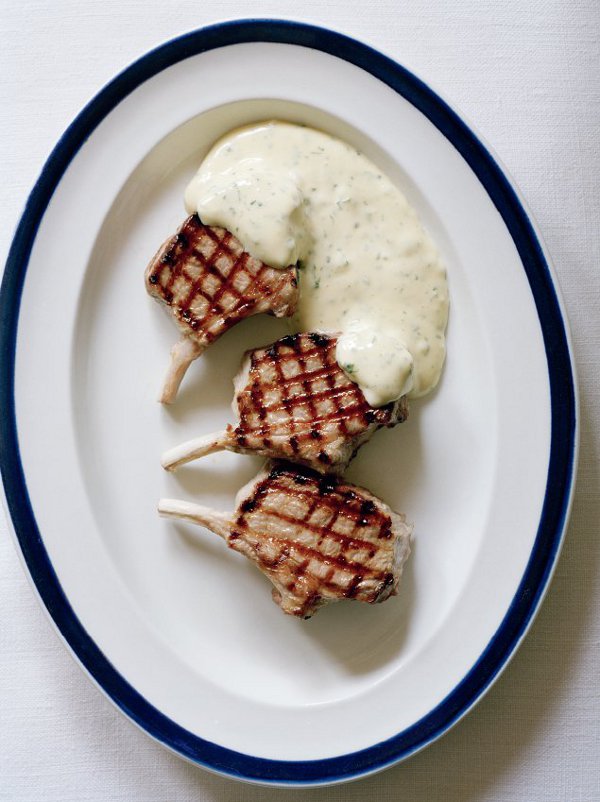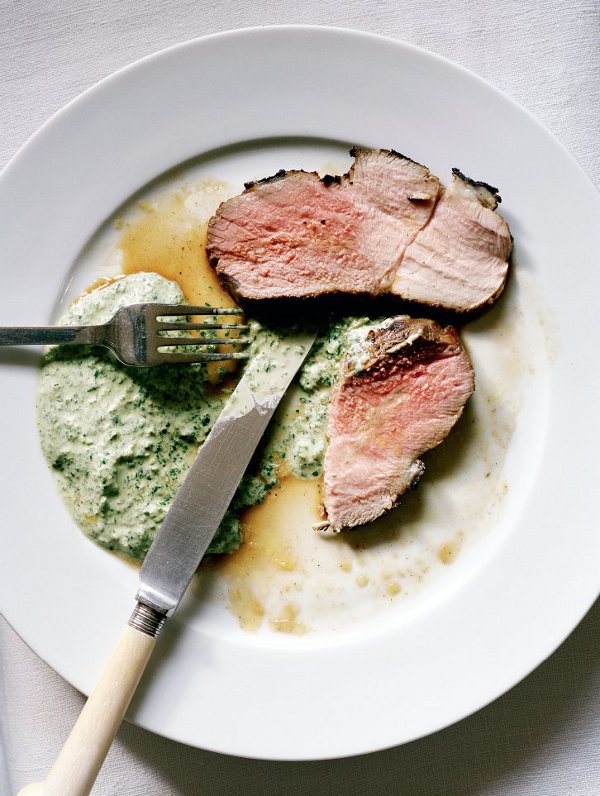Good Cook (11 page)
Authors: Simon Hopkinson

serves 4
2¼ lb boned, rolled and tied lamb breast
salt and freshly ground white pepper
a little dripping or oil
2¼ lb onions, thinly sliced
2 bay leaves
1 tbsp vinegar
2–3 tbsp anchovy essence, or to taste
2 tbsp finely chopped parsley
The Rhône meets Ramsbottom! Well … that’s how I like to see the connection between a dish that Elizabeth David wrote about in
An Omelette and a Glass of Wine
, possibly my most favorite of all her books. In one chapter she describes a dish of beef and onions, ever so slowly braised in the ovens of barges, cooked by sailors on board, as these huge vessels chugged up and down the Rhône river. It brings to mind a romantic vision of an older France, together with the simple fact that strong, hard-working men need sustenance, but that it should be truly delicious sustenance and easy to cook in cramped, overheated conditions.
The basic premise is this: sliced beef, huge amounts of onions and no liquid. Cook for hours until done. In other words, great trays of this assembly are pushed into huge ovens and forgotten about. However, a magical thing happens when onions and meat are put together with added heat; they simply make their own gravy.
Once the beef is soft and tender, together with onions all slippery and golden, other flavors of the region are put into play, making the dish a work of genius. Chopped garlic and parsley (called “persillade” in the Midi), vinegar for piquancy, some chopped anchovy for salt and finally, of course, local fruity olive oil for essential lubrication. Just perfect for the sunny Rhône valley, but maybe not for rainy old Ramsbottom, the Lancashire mill town very near to where I grew up.
That which I wanted to achieve was to turn the dish into a simple, inexpensive and homespun meal using breast of lamb. The particular ingredient used to season the barge beef, anchovies, brought to mind a
wonderful bottle of pale brown British condiment, “anchovy essence.” I have always loved this. The brand Burgess used to be my favorite, but I can’t find it any more. So Geo Watkins it must be, for me; not as pink as Burgess, but it does the job. I felt that the garlic needed to go (you may disagree, and that’s fine), but bay leaves I have added. No olive oil either, just a little natural, seeping fat from the lamb (the beef for the sailors was lean, so needed the oil). The inclusion of vinegar is unchanged, except that I am tempted to suggest a good shake of Sarson’s, rather than “un gout de vinaigre du vin,” but that is entirely a matter for you, too. However, and finally, the parsley is unanimously essential to both.
Note: if you would like to prepare the leftover dish that follows from the lamb braise (see
page 124
), make sure you cook extra meat or feed fewer.
Preheat the oven to 325°F.
Season the lamb well on all surfaces. Melt the dripping/oil in a large, roomy, lidded pot until hot. Lay in the lamb breast, turn down the heat a little and color well on all sides, until golden brown. Lift out the meat and remove all fat from the pot with a spoon. Tip in half the onions, then return the lamb to the pot and push it down into them. Pop in the bay leaves and cover with the rest of the onions.
Now, take a sheet of parchment paper and cut it into a circle slightly bigger than the diameter of the pot lid. Dampen it, lightly grease one side, and lightly press it over the onions (greased side down), while also against the side of the pot. This effects a kind of baffle over the lamb and onions, so that steam and juices stay intact, producing a moist and more flavorful result (in professional kitchens, this paper covering is known as a “cartouche”). Put on the lid, slide the pot into the oven and leave there for 1 hour.
Have a peek in the pot, now, and see how the onions are doing; they should be starting to collapse. Don’t disturb them too much, but maybe scrape some down the side of the pot where they may have stuck a bit. You should, however, be able to see some of the natural juices of the onions seeping out and moistening the assembly. Replace the paper and lid, return the pot to the oven and continue to cook for a further hour. Note: if there are plenty of juices already visible at this stage, turn the oven down to 300°F.
After 2 hours’ cooking, the onions should now almost be swimming in juices. Push a skewer into the lamb to see how tender it is; there should be little resistance. Lift out the meat, put it into a small roasting pan and cover with foil. Turn down the oven again to 275°F, and return the meat to the oven while you deal with the onions.
Remove the bay leaves. You will notice that a fair amount of fat has accumulated on the surface (lamb breast is a naturally fatty cut), so remove almost all of this with a few sheets of paper towels. Now, stir in the vinegar and anchovy essence, place the pot over a high heat and bring the onions and their juices to a simmer. Quietly reduce this mixture, stirring occasionally until sticky and beginning to become a deliciously unctuous mass; if you have ever made French onion soup, think of the early process of making that.
To finish the dish, check for seasoning; you should not need any extra salt, due to the anchovy essence, but I would always add more pepper at this stage as I like the dish quite so. Finally, stir in the parsley. Remove the lamb from the oven (if any meaty juices have seeped from the resting lamb, add them to the onions), cut off the strings and thickly slice the meat. Arrange the slices on a hot serving dish and pile the onions alongside. Mashed potatoes, anyone?

serves 2
for the garlic mayonnaise
2 egg yolks
2 cloves of garlic, crushed to a paste with a little sea salt
freshly ground white pepper
10–12 oz olive oil, not too strong in flavor, but of good quality (if you find just olive oil too overpowering, use half olive oil and half sunflower oil, say)
lemon juice, to taste
flour
beaten egg
dry breadcrumbs
dripping or oil, for frying
4 slices of cold, leftover cooked lamb breast (see previous recipe)
salt and freshly ground white pepper
Although I have removed the garlic from the braise in the previous dish, I feel moved to put it back into this very nice leftover. There is something so delicious about partnering meat that is crusted on the outside, while soft, a little fatty and moist on the inside, with a rich, emulsified and oily sauce. I’m telling you, it works really, really well.
Note: if you wish, use an electric handheld beater for ease when making the mayonnaise.
First, to make the garlic mayonnaise, place the egg yolks in a bowl with the garlic and pepper. Beginning slowly, beat together while very, very slowly trickling in the olive oil. Once the mixture is becoming very thick, add a little lemon juice. Continue beating, adding the oil a little faster and speeding up the beating speed.
Taste the mayonnaise as you continue beating, and add a touch more lemon juice and more seasoning as you think necessary. Once you are happy with the flavor and texture—which should be almost ointment-like—the garlic mayonnaise is ready. Put to one side while you cook the lamb.
Have ready 3 shallow bowls filled with the following: flour, beaten egg and dry breadcrumbs. Take a solid frying pan (non-stick, if you prefer) and in it melt a tablespoon or so of the chosen fat—you may need more—then heat it to medium-hot. First, lightly season the lamb, then dust each slice with flour, then dip it into beaten egg and, finally, coat in the breadcrumbs. Shake off any excess and slide into the frying pan. Keeping the heat moderate, but quietly sizzling, allow one side to become a pale, golden brown before carefully turning over and doing the same to the other side. Lift out on to paper towels, place the slices on warmed plates and serve the garlic mayonnaise in a bowl on the side. Some cool and sprightly watercress would be good here.

serves 2
for the minted hollandaise
3 tbsp white wine vinegar
3 tbsp water
1 small shallot, finely chopped
leaves from a small bunch of mint
3 egg yolks
2 sticks unsalted butter, melted
salt and freshly ground white pepper
a touch of lemon juice
1 rack of lamb, French-trimmed; that is, bones scraped clean and excess fat removed
salt and pepper
a little oil
I first made this lovely sauce when working in west Wales in the early 1970s. We had been making its cousin, béarnaise sauce, for as long as we could remember and wanted to ring the changes. After much exhaustive book reading, we finally came across something known as “sauce paloise.” Heaven knows its origins, or in which cookbook we found it, but it seemed a must to serve with the delicious local Welsh lamb from the butcher in St David’s.
I have chosen to simply call it “minted hollandaise,” rather than “sauce paloise” (or “mint béarnaise,” because of the essential tarragon in that sauce), mainly because it won’t mean anything to anyone; well, maybe to a few dedicated sauce aficionados, but not in the general lexicon of culinary lotions.
Note: if you wish to use the traditional method for making hollandaise sauce, see the recipe for Smoked Haddock and Spinach with Chive Butter Sauce (
page 107
).
First make the sauce. Put the vinegar, water, the shallot and two-thirds of the mint leaves, chopped, into a small, stainless steel pan. Reduce over a moderate heat until syrupy. Strain this mixture through a fine sieve into the bowl of a small food processor. Add the egg yolks, switch on and process until airy and pale. Heat the
butter until quite hot and bubbling (use a small pan with a lip, to aid pouring), then, with the motor running, slowly pour in the butter until the sauce has become thick, as with making mayonnaise; you may like to add a touch of the milky residue underneath the clear butter, as this processor method usually makes a thicker than usual sauce. Season lightly and add the remaining mint leaves. Briefly process once more, until the machine has chopped the leaves finely into the sauce. Squeeze in a touch of lemon juice, to taste. Pour into a sauceboat and keep warm.
Cut the rack of lamb into 6 cutlets, if small, and usually 8, if large. Lightly season them and brush with oil. Using a ribbed, stove-top grill (or a heavy, solid-based frying pan) on a high heat, grill the cutlets on each side for 2–3 minutes (medium-rare), 3–4 minutes (medium), and for about 5 minutes if you wish them to be medium-well to well done. Leave to rest for a few minutes before serving with the sauce. And chips—whichever way you like to make them—would be the perfect accompaniment.
serves 6–8
for the marinade
5 oz light soy sauce
2 oz sesame oil
2 cloves of garlic, peeled and crushed
½ onion, peeled and chopped
big knob of fresh ginger, peeled and sliced
juice of 1 orange
juice of 1 lemon
1 tbsp muscovado (or other dark brown) sugar
1 tsp (heaping) ground coriander
1 tsp ground cumin
1 tsp ground turmeric
½ tsp cayenne pepper
½ tsp paprika
1 leg of lamb, butterflied, to give a rough boned weight of about 2¼–3 lb
salt
oil
for the sauce
3½ oz coriander leaves
1½ oz mint leaves
8 cloves of garlic, peeled and crushed
2 tsp ground cumin
1 tsp sugar
1 heaped tsp sea salt
3 oz lime juice
7–10 green chillies
7 oz Greek yogurt
Lamb cooked in this way is terrifically tasty—whether marinated or not. The skin of the meat sizzles and blisters almost to a blackened crust, in the most agreeable fashion. I have cooked this on an open fire in Greece, where the charcoal gives an incomparable flavor to the meat, but a ribbed stove-top grill offers excellent results, too. Do make sure that you allow the lamb to rest once cooked, as this will ensure an even pink—if you like it pink, that is—hue right through the meat, while also keeping the juices intact when carving.
This is also particularly nice eaten with tzatziki (see
page 38
) on future occasions, when you may enjoy a change from the green sauce, delicious as it is. However, I am unsure as to whether one should serve both together, as there may be a clash of culinary continents, here.
Process all the ingredients for the marinade in a blender until as smooth as possible (pass through a sieve to be on the safe side, if you like). Lay the lamb in a large lidded pot or plastic container, and pour over the marinade. Massage the mixture into the meat, turning it over and over, until well coated. Cover with the lid (or plastic wrap or kitchen foil) and put into the fridge for 24—and up to 48—hours, turning occasionally. Lift out the meat from the marinade, shake off excess liquid and drain well in a colander, say, then pat dry with paper towels. Season well with salt and smear oil over the entire surface; hands are best here.
Heat a large, stove-top ribbed grill to medium-hot or, even better, a charcoal-fired barbecue; this will give the most perfect and authentic results. Otherwise, preheat the oven to 400°F, and put the lamb on a wire rack fitted inside a roasting dish.
If using the grill or barbecue method (the cook should keep the grill/coals at moderate to high temperature), lay the meat down and leave to quietly crust over the heat for about 20 minutes. Turn over and repeat (this is timed for nicely pink meat). If you choose to take the oven route, the turnings and timings remain about the same, but check that the lamb does not brown too much. Remove to a large serving platter and leave to rest for at least 10 minutes—and up to half an hour—while kept warm, loosely covered with foil if necessary (see
page 320
). Note: it is intentional that the surface will have become slightly blackened in parts, but the resultant pink inside contrasts winningly with the carbonized exterior.
Meanwhile, place all the green sauce ingredients in a small food processor and make a smooth, slack purée. Pour out into a bowl and set aside until the lamb is ready.
Transfer the lamb to a board and neatly carve into thin slices. Return them to the platter, collect any resultant juices and spoon over the meat. Serve with the green sauce and a plain green salad of, say, crisp romaine leaves simply dressed with lemon and olive oil.

